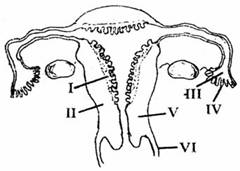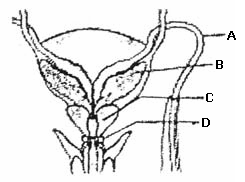NEET Human Reproduction Questions | Chapter wise MCQ Test on NEET Human Production | Test no. 04
Human Reproduction MCQs Quiz - 04
Congratulations - you have completed Human Reproduction MCQs Quiz - 04.
You scored %%SCORE%% out of %%TOTAL%%.
Your performance has been rated as %%RATING%%
Your answers are highlighted below.
Question 1 |
Human seminal plasma, the fluid part of semen, is produced by contributions from the:
i. Urethra
ii. Prostate
iii. Seminal vesicle
iv. Bulbourethral gland
i and iii | |
i and iv | |
i, iii and iv | |
ii, iii and iv |
Question 2 |
Which one of the following statement is correct?
Spermatogenesis is the formation of sperm cells. | |
Spermatogenesis occurs in the seminiferous tubules. | |
Follicle-stimulating hormone (FSh) indirectly stimulates spermatogenesis. | |
All of these are correct |
Question 3 |
Which one of the following statements is incorrect about menopause?
Generally occurs between the ages of 45 and 55 | |
Causes the cessation of the female reproductive cycle | |
Anterior pituitary no longer produces FSH and LH | |
Ovaries slowly reduce their secretion of estrogen |
Question 4 |
Which one of the following statement is correct about sertoli cells also called as nurse cells?
Found in adrenal cortex and secrete adrenaline | |
Found in ovaries and secrete progesterone | |
Found in pancreas and secrete cholecystokinin | |
Found in Seminiferous tubules and provide nutrition of germ cells |
Question 5 |
Which one of the following statements about morula in humans is correct?
It has more cytoplasm and more DNA than an uncleaved zygote | |
It has almost equal quantity of cytoplasm as an uncleaved zygote but much more DNA | |
It has far less cytoplasm as well as less DNA than in an uncleaved zygote | |
It has more or less equal quantity of cytoplasm and DNA as in uncleaved zygote |
Question 6 |
Foetal ejection reflex in human female is induced by
Differentiation of mammary glands | |
Pressure exerted by amniotic fluid | |
Release of oxytocin from pituitary | |
Fully developed foetus and placenta |
Question 7 |
Which one of the following is the most likely root cause why menstruation is not taking place in regularly cycling human female?
Retention of well-developed corpus luteum | |
Fertilisation of the ovum | |
Maintenance of the hypertrophical endometrial lining | |
Maintenance of high concentration of sex-hormones in the blood stream |
Question 8 |
The correct sequence of spermatogenetic stages leading to the formation of sperms in a mature human testis is
Spermatogonia-spermatid-spermatocyte-sperms | |
Spermatocyte-spermatogonia-spermatid-sperms | |
Spermatogonia-spermatocyte-spermatid-sperms | |
Spermatid-spermatocyte-spermatogonia-sperms |
Question 9 |
Correct sequence of embryo development:
Gamete → Zygote → Morula → Blastula → Gastrula | |
Gamete → Zygote → Blastula → Morula → Gastrula | |
Gamete → Neurula → Gastrula | |
Gamete → Neurula → Morula |
Question 10 |
Which one of the following statements is incorrect about menstruation?
The beginning of the cycle of menstruation is called menarche | |
During normal menstruation about 40 ml blood is lost | |
The menstrual fluid can easily clot | |
At menopause in the female, there is especially abrupt increase in gonadotropic hormones |
Question 11 |
The hemoglobin of a human foetus:
Has a higher affinity for oxygen than that of an adult | |
Has a lower affinity for oxygen than that of the adult | |
Its affinity for oxygen is the same as that of an adult | |
Has only two protein subunits instead of four |
Question 12 |
What happens during fertilisation in humans after many sperms reach close to the ovum?
Cells of corona radiata trap all the sperms except one | |
Only two sperms nearest the ovum penetrate zona pellucida | |
Secretions of acrosome helps one sperm enter cytoplasm of ovum through zona pellucida | |
All sperms except the one nearest to the ovum lose their tails |
Question 13 |
Column I contains terms and column II contains definitions. Match them correctly and choose the right answer.
| Column I | Column II | ||
| A | Parturition | p | Attachment of zygote to endometrium |
| B | Gestation | q | Release of egg from Graafian follicle |
| C | Ovulation | r | Delivery of baby from uterus |
| D | Implantation | s | Duration between pregnancy and birth |
| E | Conception | t | Formation of zygote by fusion of the egg and sperm |
| u | Stoppage of ovulation and menstruation |
A = q, B = s, C = p, D = t, E = r | |
A = s, B = r, C = p, D = t, E = q | |
A = t, B = p, C = q, D = r, E = s | |
A = r, B = s, C = q, D = p, E = t |
Question 14 |
The figure given below depicts a diagrammatic sectional view of the female reproductive system of humans.
Which one set of three parts out of I – VI have been correctly identified?


(I) Perimetrium, (II) Myometrium, (III) Fallopian tube | |
(II) Endometrium, (III) Infundibulum, (IV) Fimbriae | |
(III) Infundibulum, (IV) Fimbriae, (V) Cervix | |
(IV) Oviducal funnel, (V) Uterus, (VI) Cervix |
Question 15 |
Given below is a diagrammatic sketch of a portion of human male reproductive system. Select the correct set of the names of the parts labelled A, B, C, D.


| A | B | C | D | |
| (1) | Ureter | Seminal vesicle | Prostate | Bulbourethral gland |
| (2) | Ureter | Prostate | Seminal vesicle | Bulbourethral gland |
| (3) | Vas deferens | Seminal vesicle | Prostate | Bulbourethral gland |
| (4) | Vas deferens | Seminal vesicle | Bulbourethral gland | Prostate |
Option (1) | |
Option (2) | |
Option (3) | |
Option (4) |
Once you are finished, click the button below. Any items you have not completed will be marked incorrect.
There are 15 questions to complete.
Tags: NEET Biology MCQs | NEET Biology Practice Questions | NEET Biology Previous Questions | NEET Biology Questions Chapter wise



These test papers are just awesome.due to these papers we really do best in exams.
THANKS ALL THE TEAM MEMBERS OF THIS SITE.THANK U ALL!!!!!!!!!!!
I Thought during menopause the level of gonadotropic hormone decreases
ankusha you must remember that menopause has nothing to do gonadotropic hormone but it is because decreasing level of estrogen and menstrual blood do not clot beause of several anticogulants like (gp89) present in it..i think you might be confusing only in these two parts of mcq…
i have some doubts in que 10… can someone help me out????
10th question is absolutely correct nd quiet easy…during menstruation blood cannot easily clot cuz.in the blood, fibrinolysin is present which is an anticoagulant factor and helps in the control of coagulation of blood
menstrual fluid contains a proenzyme called PROFIBRINOLYSIN that is responsible for the non clotting character of menses…
all correct!! phew. anyways nice set of questions!! logical thinking also comes into play!!
this helped me alot thankx